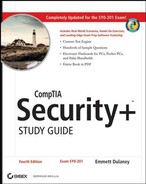E
- EAL
See Evaluation Assurance Level (EAL).
- eavesdropping
Any type of passive attack that intercepts data in an unauthorized manner—usually in order to find passwords. Cable sniffing, wiretapping, and man-in-the-middle attacks are eavesdropping attacks.
- ECC
See Elliptic Curve Cryptosystem (ECC).
- EF
See exposure factor (EF).
- electromagnetic interference (EMI)
The interference that can occur during transmissions over copper cable because of electromagnetic energy outside the cable. The result is degradation of the signal.
- Elliptic Curve Cryptosystem (ECC)
A type of public key cryptosystem that requires a shorter key length than many other cryptosystems (including the de facto industry standard, RSA).
- EMI
See electromagnetic interference (EMI).
- Encapsulating Security Payload (ESP)
A header used to provide a mix of security services in IPv4 and IPv6. ESP can be used alone or in combination with the IP Authentication Header (AH).
- encoding
The process of translating data into signals that can be transmitted on a transmission medium.
- encryption
The process of converting data into a form that makes it less likely to be usable to anyone intercepting it if they can't decrypt it.
- encryption key
A string of alphanumeric characters used to decrypt encrypted data.
- enticement
The process of luring someone.
- entrapment
The process of encouraging an attacker to perform an act, even if they don't want to do it.
- enumeration
An attempt to gain information about a network by specifically targeting network resources, users and groups, and applications running on the system.
- escalation
The act of moving something up in priority. Often, when an incident is escalated, it's brought to the attention of the next highest supervisor. See also privilege escalation.
- Ethernet
A shared-media network architecture. It operates at the Physical and Data Link layers of the Open Systems Interconnection (OSI) model. As the media access method, it uses baseband signaling over either a bus or a star topology. The cabling used in Ethernet networks can be coax, twisted-pair, wireless, or fiber-optic.
- Ethernet address
See MAC address.
- Evaluation Assurance Level (EAL)
A level of assurance, expressed as a numeric value, based on standards set by the Common Criteria Recognition Agreement (CCRA).
- event
Any noticeable action or occurrence.
- exposure factor (EF)
A calculation of how much data (or other assets) could be lost from a single occurrence. If all the data on the network could be jeopardized by a single attack, the exposure factor is 100 percent.
- external threat
A threat that originates from outside the company.
- extranet
Web (or similar) services set up in a private network to be accessed internally and by select external entities, such as vendors and suppliers.
- extrusion
Examining data leaving a network for signs of malicious traffic.
